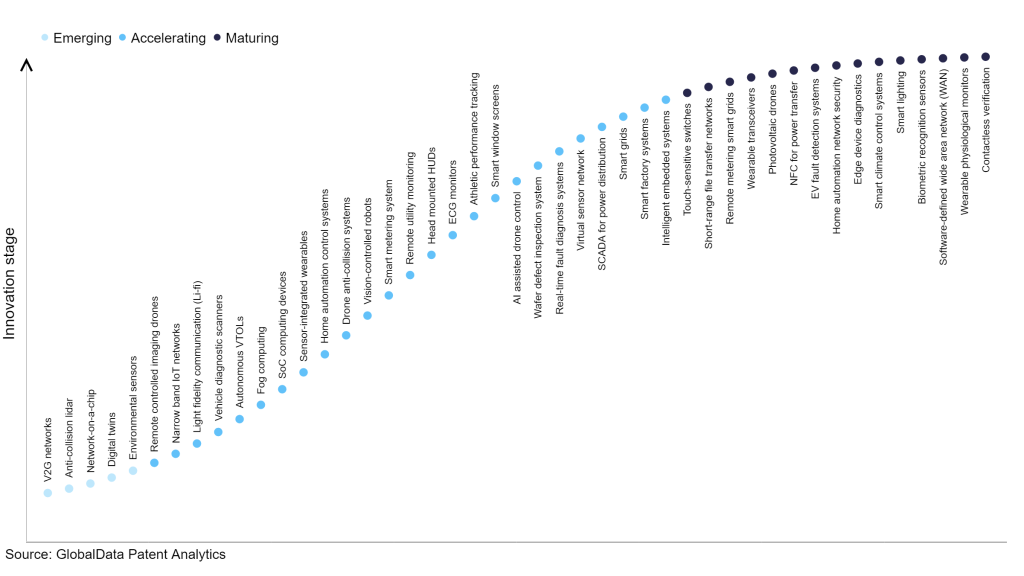The technology industry continues to be a hotbed of innovation, with activity driven by digital transformation, automation, increased connectivity, and business imperatives to become more efficient and competitive in a rapidly changing marketplace, and growing importance of technologies such as Internet of Things (IoT) and advanced light detection and ranging (LiDAR) systems to ensure the safety and reliability of autonomous systems in various industrial applications. In the last three years alone, there have been over 3.6 million patents filed and granted in the technology industry, according to GlobalData’s report on Innovation in Internet of Things: Anti-collision LiDAR. Buy the report here.
However, not all innovations are equal and nor do they follow a constant upward trend. Instead, their evolution takes the form of an S-shaped curve that reflects their typical lifecycle from early emergence to accelerating adoption, before finally stabilising and reaching maturity.
Identifying where a particular innovation is on this journey, especially those that are in the emerging and accelerating stages, is essential for understanding their current level of adoption and the likely future trajectory and impact they will have.
300+ innovations will shape the technology industry
According to GlobalData’s Technology Foresights, which plots the S-curve for the technology industry using innovation intensity models built on over 2.5 million patents, there are 300+ innovation areas that will shape the future of the industry.
Within the emerging innovation stage, environmental sensors, digital twins, and network-on-a-chip are disruptive technologies that are in the early stages of application and should be tracked closely. Intelligent embedded systems, smart factory systems, and smart grids are some of the accelerating innovation areas, where adoption has been steadily increasing. Among maturing innovation areas, contactless verification, wearable physiological monitors, and software-defined wide area network are now well established in the industry.
Innovation S-curve for IoT in the technology industry

Anti-collision LiDAR is a key innovation area in IoT
Anti-collision LiDAR belongs to a category of light detection and ranging technologies which can sense the existence of entities in a specific region and assist in averting collisions. This mechanism operates by releasing laser beams into the surrounding area, which consequently reflects off close-by objects and is captured by the detector. The resulting information is employed to establish a three-dimensional layout of the surroundings, facilitating the identification and evasion of potential barriers.
GlobalData’s analysis also uncovers the companies at the forefront of each innovation area and assesses the potential reach and impact of their patenting activity across different applications and geographies. According to GlobalData, there are 40+ companies, spanning technology vendors, established technology companies, and up-and-coming start-ups engaged in the development and application of anti-collision LiDAR.
Key players in anti-collision LiDAR – a disruptive innovation in the technology industry
‘Application diversity’ measures the number of different applications identified for each relevant patent and broadly splits companies into either ‘niche’ or ‘diversified’ innovators.
‘Geographic reach’ refers to the number of different countries each relevant patent is registered in and reflects the breadth of geographic application intended, ranging from ‘global’ to ‘local’.
Patent volumes related to anti-collision LiDAR
Source: GlobalData Patent Analytics
Among the companies innovating in anti-collision LiDAR, Ford Motor is the leading patent filer. One of the company’s patents, for example, is aimed at developing a system comprising a camera to capture an image of a forward path of the vehicle, a screen to display the image, and a processor, which can respond to an input to the screen by identifying and measuring the distance between two edges of at least one object of the image.
Other prominent patent filers in the anti-collision LiDAR space include Amazon.com and Alphabet.
By geographic reach, ELMOS Semiconductor leads the pack, followed by BAE Systems and Seoul Robotics. In terms of application diversity, Aptiv holds the top position, followed by Uatc and Magna International.
Anti-collision LiDAR technology is essential for the safe and efficient operation of autonomous systems. Its significance will continue to grow as the use of autonomous systems becomes more prevalent in various industries.
To further understand how IoT is disrupting the technology industry, access GlobalData’s latest thematic research report on Internet of Things – Thematic Research.
Data Insights
From

The gold standard of business intelligence.
Blending expert knowledge with cutting-edge technology, GlobalData’s unrivalled proprietary data will enable you to decode what’s happening in your market. You can make better informed decisions and gain a future-proof advantage over your competitors.







